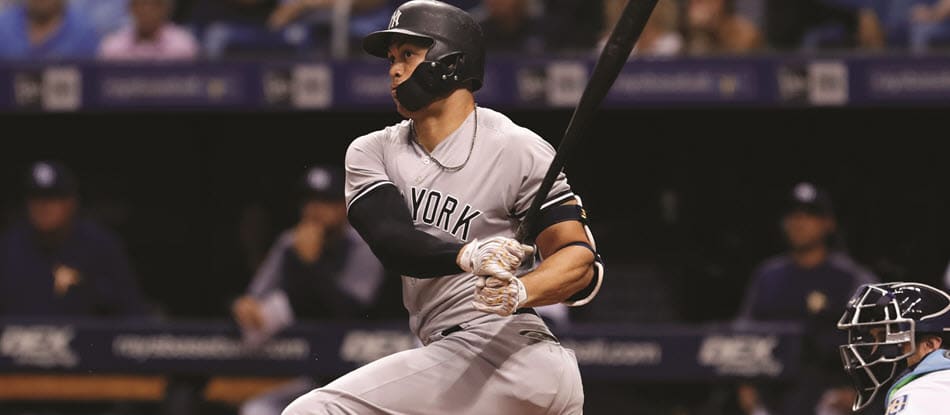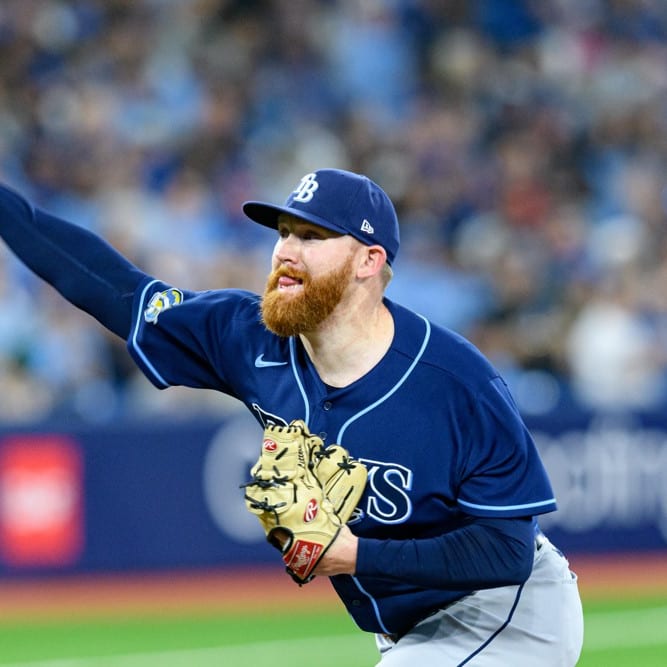This article is part of our MLB Barometer series.
With news slowing to a trickle due to the league's transaction freeze, there isn't a whole lot of rising and falling going on. While I'll still be covering the most important risers and fallers each week, I'll try to avoid scraping the bottom of the barrel just to come up with the customary 10 names. To keep this column useful and interesting during these unusual times, I'll expand the introductory section to share some research I've done on some more general fantasy baseball topics.
Up first: How reliable are the league's top base stealers from one season to the next?
I rarely finish my drafts projecting to be among the league leaders in steals. I don't punt the category entirely by any means, but I consistently find myself lower than the market on the likes of Trea Turner, Adalberto Mondesi or Jonathan Villar. I regularly catch myself thinking something along the lines of, "Sure, if Turner hits .290 with 20 homers and 40 steals, I'd love him at his price, but what if he steals 20? What if he steals 10?"
To assess whether that fear is reasonable, I grabbed all the players who were in the top 10 (or tied for a top-10 spot) in steals over the last decade and looked at how many bases they stole the following season. I'll share the data and my biggest takeaways below. My full spreadsheet can be found here for those of you who feel like fantasy content has
With news slowing to a trickle due to the league's transaction freeze, there isn't a whole lot of rising and falling going on. While I'll still be covering the most important risers and fallers each week, I'll try to avoid scraping the bottom of the barrel just to come up with the customary 10 names. To keep this column useful and interesting during these unusual times, I'll expand the introductory section to share some research I've done on some more general fantasy baseball topics.
Up first: How reliable are the league's top base stealers from one season to the next?
I rarely finish my drafts projecting to be among the league leaders in steals. I don't punt the category entirely by any means, but I consistently find myself lower than the market on the likes of Trea Turner, Adalberto Mondesi or Jonathan Villar. I regularly catch myself thinking something along the lines of, "Sure, if Turner hits .290 with 20 homers and 40 steals, I'd love him at his price, but what if he steals 20? What if he steals 10?"
To assess whether that fear is reasonable, I grabbed all the players who were in the top 10 (or tied for a top-10 spot) in steals over the last decade and looked at how many bases they stole the following season. I'll share the data and my biggest takeaways below. My full spreadsheet can be found here for those of you who feel like fantasy content has been light on mentions of Nyjer Morgan and Scott Podsednik lately.
Players | Year 1 Steals | Year 2 Steals | Avg. Steals Lost | % of Steals Lost | % Losing 10+ Steals | % Losing 20+ Steals |
|---|---|---|---|---|---|---|
108 | 40.6 | 28.0 | 12.6 | 31.0% | 62.0% | 22.2% |
The typical elite steal guy loses 12.6 steals from year-to-year, or 31.0 percent of last year's total. What goes into this decline? Some of it simply reflects the parameters of the study. If we're only looking at the top few base stealers, we're looking at players for whom things generally broke right last season, as it's hard to top leaderboards while fighting a lot of bad luck. When that luck neutralizes, players lose steals. Aging (a topic I'll get to soon) is another factor, as are injuries (a topic I'll get to even sooner). Another factor, however, might be that players just suddenly start to run less, which is my biggest fear when drafting speed-first players.
For those who assume that the effect in the above table is primarily the product of injuries, take a look at this second table, where all players who missed at least half of the following season are removed from the sample. (This leaves in guys who played, say, 95 games, but a line had to be drawn somewhere, and half a season felt fair.)
Players | Year 1 Steals | Year 2 Steals | Avg. Steals Lost | % of Steals Lost | % Losing 10+ Steals | % Losing 20+ Steals |
|---|---|---|---|---|---|---|
96 | 40.5 | 30.0 | 10.5 | 25.9% | 57.3% | 14.6% |
Removing those players only shrinks the sample by 12. The effect is reduced somewhat, particularly among those whose steals totals completely collapse, but it's still very real. As a side note, I'm not entirely sure that it's wise to remove injured players. As Rob Silver points out in an excellent discussion of "antifragility" here, "You never want to put yourself in a position where the loss of any one player is crippling." Players will get injured, and it might be your top steals guy. The chances of losing 30 or more projected steals in one instant can't be ignored, which is part of the reason I'm nervous about investing in such players early.
For the rest of this analysis, however, I'm restricting things to only players who played the majority of the following season, as I don't want small samples being skewed too much by one or two extended absences.
While the above numbers suggest it's wise to knock off about a quarter of an elite speed guy's steals when projecting this year's totals, it stands to reason that different archetypes of player would face different risks. Would an elite hitter like Ronald Acuna be more likely to see his steals collapse because he's too valuable for the team to take a chance on losing to a fractured thumb? Or would a weak hitter like Mallex Smith face a greater risk because he simply might not be playable despite his speed? I separated my sample into buckets, divided by wRC+, and what I saw I frankly can't entirely make sense of.
wRC+ | Players | Year 1 Steals | Year 2 Steals | Avg. Steals Lost | % of Steals Lost | % Losing 10+ Steals | % Losing 20+ Steals |
|---|---|---|---|---|---|---|---|
90 or Less | 29 | 41.4 | 32.4 | 9.0 | 21.7% | 48.3% | 17.2% |
91 to 110 | 33 | 41.3 | 28.8 | 12.5 | 30.3% | 63.6% | 12.1% |
111 or More | 34 | 39.1 | 29.2 | 9.9 | 25.3% | 58.8% | 14.7% |
The strongest effect comes not from bad hitters losing playing time or elite hitters preserving their bodies, but from roughly average hitters. I have to admit to being stumped by this one. While it could be simply a small-sample oddity, I'd welcome any possible explanations in the comments. Regardless of the reason, I'm inclined, based on this table, to not be extra afraid of weak-hitting, pure speed players, and I'm also not going to be extra afraid of stars suddenly deciding not to run.
Another area that made sense to investigate was the effect of age. We know that aging curves only get steeper over time, and it made sense that such an effect would only be exaggerated in a stat that is so heavily influenced by pure athleticism. This time, the data did align with that intuition.
Age | Players | Year 1 Steals | Year 2 Steals | Avg. Steals Lost | % of Steals Lost | % Losing 10+ Steals | % Losing 20+ Steals |
|---|---|---|---|---|---|---|---|
25 and Younger | 18 | 40.6 | 33.1 | 7.5 | 18.5% | 50.0% | 5.6% |
26 to 28 | 33 | 40.3 | 31.0 | 9.3 | 23.1% | 48.5% | 9.1% |
29 to 31 | 28 | 40.4 | 28.6 | 11.8 | 29.2% | 67.9% | 21.4% |
32 and Older | 17 | 41.1 | 27.4 | 13.7 | 33.3% | 64.7% | 17.6% |
This table shows pretty much exactly what you'd expect. Younger players do still lose steals, but those in the youngest bracket lose little more than half as many as those in the oldest bracket. Older players see an even more significant increase in their likelihood of their steals total dropping by at least 20, even with extended injury-related absences removed.
What are the main takeaways from this research? First, it's clear that we should expect most players who stole 25 or more bases last season (the cutoff point for the top 10) to see their steals totals drop fairly significantly this year. I believe many drafters expect this group to steal an equal number of bases or to even see their numbers improve, so there could be value to be had in betting against such players during draft season. The risk of these players seeing their steals totals completely collapse is quite low, however.
Additionally, there's seemingly no additional risk for either particularly weak bats like Mallex Smith and Adalberto Mondesi or particularly strong bats like Ronald Acuna and Christian Yelich. Age seems to be far more relevant, with players 29 years or older having a roughly two-in-three chance of seeing their steals totals drop by at least 10. Knowing that, I'm unlikely to find myself with many shares of Starling Marte, Jonathan Villar or Tommy Pham this season.
With that topic out of the way, it's back to our regularly scheduled programming. Please let me know in the comments if you're interested in more of this sort of thing or if you don't care because you always skip the introduction anyway (in which case you're unlikely to be reading this sentence, I suppose).
RISERS
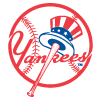 Giancarlo Stanton, OF, Yankees: Some of the news that's managed to slip through during this period of stasis has been positive. It's seemed fairly likely for a while that Stanton would have a good chance to be ready to return from his calf strain when play eventually resumed, but manager Aaron Boone removed all doubt Sunday, stating that Stanton is already fully healthy. Obviously, given the outfielder's injury history (he's averaged 116 games per season over his 10-year career), it's entirely possible he gets injured again before play resumes or shortly thereafter, though his recent injury-proneness may be slightly overstated, as he played 159 games in 2017 and 158 in 2018. In any case, drafting a player who might get injured is very different from drafting one who is currently injured, so Stanton should be shooting back up draft boards. His power potential is worth the injury risk in most circumstances.
Giancarlo Stanton, OF, Yankees: Some of the news that's managed to slip through during this period of stasis has been positive. It's seemed fairly likely for a while that Stanton would have a good chance to be ready to return from his calf strain when play eventually resumed, but manager Aaron Boone removed all doubt Sunday, stating that Stanton is already fully healthy. Obviously, given the outfielder's injury history (he's averaged 116 games per season over his 10-year career), it's entirely possible he gets injured again before play resumes or shortly thereafter, though his recent injury-proneness may be slightly overstated, as he played 159 games in 2017 and 158 in 2018. In any case, drafting a player who might get injured is very different from drafting one who is currently injured, so Stanton should be shooting back up draft boards. His power potential is worth the injury risk in most circumstances.
 Willie Calhoun, OF, Rangers: In similarly encouraging news, Calhoun's availability for Opening Day no longer appears in doubt. The outfielder underwent jaw surgery in early March after getting struck in the face by a fastball from Julio Urias. The delayed start to the season already seemed to be a boost to his value, though his timeline hadn't been particularly clear. He confirmed Thursday that he's resumed baseball activities, however, so there should be little doubt about his readiness for the upcoming season. The 25-year-old was something of a sleeper before his injury and can now be drafted as if he's uninjured. He broke out to hit .269/.323/.524 with 21 homers in 83 games last season. I should note, though, that despite including him as a riser for health reasons, I wouldn't be anointing him as a surefire 40-homer hitter just yet. His xSLG came in at a modest .452 last season, and it remains to be seen how much less hitter-friendly the Rangers' new home park will be.
Willie Calhoun, OF, Rangers: In similarly encouraging news, Calhoun's availability for Opening Day no longer appears in doubt. The outfielder underwent jaw surgery in early March after getting struck in the face by a fastball from Julio Urias. The delayed start to the season already seemed to be a boost to his value, though his timeline hadn't been particularly clear. He confirmed Thursday that he's resumed baseball activities, however, so there should be little doubt about his readiness for the upcoming season. The 25-year-old was something of a sleeper before his injury and can now be drafted as if he's uninjured. He broke out to hit .269/.323/.524 with 21 homers in 83 games last season. I should note, though, that despite including him as a riser for health reasons, I wouldn't be anointing him as a surefire 40-homer hitter just yet. His xSLG came in at a modest .452 last season, and it remains to be seen how much less hitter-friendly the Rangers' new home park will be.
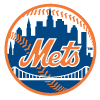 Michael Wacha, SP, Mets: Wacha appeared to be in a battle with Steven Matz and Rick Porcello for the Mets' final two rotation spots, but he didn't seem to be a favorite. After Noah Syndergaard's Tommy John surgery, however, all three are now in line to open the season in the rotation. Wacha is hardly exciting coming off a season in which he posted a 4.76 ERA and a 5.61 FIP, but he's a whole lot more exciting now that he has a job. With a respectable 3.91 career ERA, backed up by a passable 20.5 percent strikeout rate and an 8.2 percent walk rate, he fits right in with a group of similarly boring but capable starters who go in the reserve rounds of a 15-team mixed league like Jose Quintana, Marco Gonzales, Julio Teheran or the aforementioned Porcello.
Michael Wacha, SP, Mets: Wacha appeared to be in a battle with Steven Matz and Rick Porcello for the Mets' final two rotation spots, but he didn't seem to be a favorite. After Noah Syndergaard's Tommy John surgery, however, all three are now in line to open the season in the rotation. Wacha is hardly exciting coming off a season in which he posted a 4.76 ERA and a 5.61 FIP, but he's a whole lot more exciting now that he has a job. With a respectable 3.91 career ERA, backed up by a passable 20.5 percent strikeout rate and an 8.2 percent walk rate, he fits right in with a group of similarly boring but capable starters who go in the reserve rounds of a 15-team mixed league like Jose Quintana, Marco Gonzales, Julio Teheran or the aforementioned Porcello.
 Spencer Howard, SP, Phillies: I mentioned Howard as a potential beneficiary of the shortened season in my Delayed Season Primer 10 days ago. Speculation has since picked up that he could have a legitimate shot to be the Phillies' fifth starter on the Opening Day roster. While the 23-year-old has yet to reach Triple-A and has only made six starts at the Double-A level, pitchers can move quite fast once they're deemed ready, and the Phillies certainly fit the profile of a team who will want to call up its top prospects as soon as possible as they aim to end an eight-year playoff drought. The main thing holding back an early promotion would have been that the Phillies are worried about Howard's workload, as he made just 15 starts last season, but a presumably shortened schedule means that's now a significantly smaller concern. Howard's 34.8 percent strikeout rate, 0.83 WHIP and 2.03 ERA last year look a whole lot like Chris Paddack's 35.3 percent strikeout rate, 0.82 WHIP and 2.10 ERA from 2018. Paddack pitched quite well in his debut last season despite making just seven Double-A starts the season before, and while his results don't represent the default expectation for Howard, they do give some sense as to his upside.
Spencer Howard, SP, Phillies: I mentioned Howard as a potential beneficiary of the shortened season in my Delayed Season Primer 10 days ago. Speculation has since picked up that he could have a legitimate shot to be the Phillies' fifth starter on the Opening Day roster. While the 23-year-old has yet to reach Triple-A and has only made six starts at the Double-A level, pitchers can move quite fast once they're deemed ready, and the Phillies certainly fit the profile of a team who will want to call up its top prospects as soon as possible as they aim to end an eight-year playoff drought. The main thing holding back an early promotion would have been that the Phillies are worried about Howard's workload, as he made just 15 starts last season, but a presumably shortened schedule means that's now a significantly smaller concern. Howard's 34.8 percent strikeout rate, 0.83 WHIP and 2.03 ERA last year look a whole lot like Chris Paddack's 35.3 percent strikeout rate, 0.82 WHIP and 2.10 ERA from 2018. Paddack pitched quite well in his debut last season despite making just seven Double-A starts the season before, and while his results don't represent the default expectation for Howard, they do give some sense as to his upside.
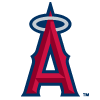 Griffin Canning, SP, Angels: Tommy John surgery appeared to be on the table for Canning when the elbow issues that prematurely ended his rookie campaign resurfaced in late February. The odd initial diagnosis of "chronic changes to the UCL" wasn't exactly reassuring. Even after a second opinion, however, he wound up simply undergoing a platelet-rich plasma injection rather than surgery, and he's now expected to resume throwing sometime this week. Canning's placement on this list doesn't mean I'm particularly confident in his health, as it's quite nerve-wracking to draft a player who has dealt with elbow problems twice in the last seven months. Canning's situation isn't analogous to Chris Sale's, however, as you're likely taking him low enough that if you have to cut him right away you're not losing too much. For that kind of price, I'm happy to take a shot on a guy who managed a 25.0 percent strikeout rate and a 7.8 percent walk rate as a rookie.
Griffin Canning, SP, Angels: Tommy John surgery appeared to be on the table for Canning when the elbow issues that prematurely ended his rookie campaign resurfaced in late February. The odd initial diagnosis of "chronic changes to the UCL" wasn't exactly reassuring. Even after a second opinion, however, he wound up simply undergoing a platelet-rich plasma injection rather than surgery, and he's now expected to resume throwing sometime this week. Canning's placement on this list doesn't mean I'm particularly confident in his health, as it's quite nerve-wracking to draft a player who has dealt with elbow problems twice in the last seven months. Canning's situation isn't analogous to Chris Sale's, however, as you're likely taking him low enough that if you have to cut him right away you're not losing too much. For that kind of price, I'm happy to take a shot on a guy who managed a 25.0 percent strikeout rate and a 7.8 percent walk rate as a rookie.
FALLERS
 Brendan McKay, SP, Rays: McKay posted a solid 4.03 FIP in his 49-inning debut last season, pairing a 25.9 percent strikeout rate with a 7.4 percent walk rate, but a high BABIP and a low strand rate led to a poor 5.14 ERA. I was a fan of his early in draft season based on those strong small-sample peripherals and his dominant 1.10 ERA and 36.7 percent strikeout rate in the high minors. His stock took a hit Thursday, however, as he was optioned to Triple-A Durham. While he could presumably be called back up before play resumes, the transaction seems to indicate the Rays will be bringing him along slowly this season. While the lefty is undeniably talented, his team is simply too creative with its pitching staff to trust anyone but their most established arms. McKay could certainly throw quite a few innings at the big-league level this season, but he currently appears to be behind Ryan Yarbrough and Yonny Chirinos in the battle for the final two rotation spots (assuming the Rays bother to run a five-man rotation rather than a collection of openers).
Brendan McKay, SP, Rays: McKay posted a solid 4.03 FIP in his 49-inning debut last season, pairing a 25.9 percent strikeout rate with a 7.4 percent walk rate, but a high BABIP and a low strand rate led to a poor 5.14 ERA. I was a fan of his early in draft season based on those strong small-sample peripherals and his dominant 1.10 ERA and 36.7 percent strikeout rate in the high minors. His stock took a hit Thursday, however, as he was optioned to Triple-A Durham. While he could presumably be called back up before play resumes, the transaction seems to indicate the Rays will be bringing him along slowly this season. While the lefty is undeniably talented, his team is simply too creative with its pitching staff to trust anyone but their most established arms. McKay could certainly throw quite a few innings at the big-league level this season, but he currently appears to be behind Ryan Yarbrough and Yonny Chirinos in the battle for the final two rotation spots (assuming the Rays bother to run a five-man rotation rather than a collection of openers).
 Clint Frazier, OF, Yankees: There was a brief period this spring where it seemed to be time to jump back on the Clint Frazier train. Giancarlo Stanton and Aaron Judge were expected to miss Opening Day and perhaps considerably longer with their calf and rib injuries, respectively. Frazier didn't necessarily have a path to a starting role for the entirety of the season, but he was at least going to finally have a temporary gig, with the potential to carve out a longer-term role should he impress early. With the delayed season, Stanton is healthy again, and Judge should at worst not miss nearly as much time as previously expected. That leaves Frazier back in the same limbo where he's spent most of the last two seasons. It's not impossible to envision Mike Tauchman being a one-season wonder and ceding the job to Frazier at some point, but it was a lot easier to take a chance on Frazier when there was at least a temporary guarantee of playing time.
Clint Frazier, OF, Yankees: There was a brief period this spring where it seemed to be time to jump back on the Clint Frazier train. Giancarlo Stanton and Aaron Judge were expected to miss Opening Day and perhaps considerably longer with their calf and rib injuries, respectively. Frazier didn't necessarily have a path to a starting role for the entirety of the season, but he was at least going to finally have a temporary gig, with the potential to carve out a longer-term role should he impress early. With the delayed season, Stanton is healthy again, and Judge should at worst not miss nearly as much time as previously expected. That leaves Frazier back in the same limbo where he's spent most of the last two seasons. It's not impossible to envision Mike Tauchman being a one-season wonder and ceding the job to Frazier at some point, but it was a lot easier to take a chance on Frazier when there was at least a temporary guarantee of playing time.
 Nate Pearson, SP, Blue Jays: Whether a prospect benefits from a delayed and shortened season depends in large part on his team's circumstances. In contrast to Spencer Howard, Pearson might end up being hurt by the changes. The Blue Jays don't appear poised to compete this season, so even though Pearson has reached Triple-A and is undeniably talented, the team sees little reason to rush him. He'll apparently be asked to prove himself in Triple-A Buffalo over a much larger sample than the three starts he made there last season. If the schedule is significantly reduced, that won't leave much time for him to make a big-league impact. While he could certainly force the Blue Jays' hand with a hot start, there doesn't appear to be a chance he breaks camp with the team, and there's a possibility he doesn't pitch in the majors at all if the schedule is shortened significantly.
Nate Pearson, SP, Blue Jays: Whether a prospect benefits from a delayed and shortened season depends in large part on his team's circumstances. In contrast to Spencer Howard, Pearson might end up being hurt by the changes. The Blue Jays don't appear poised to compete this season, so even though Pearson has reached Triple-A and is undeniably talented, the team sees little reason to rush him. He'll apparently be asked to prove himself in Triple-A Buffalo over a much larger sample than the three starts he made there last season. If the schedule is significantly reduced, that won't leave much time for him to make a big-league impact. While he could certainly force the Blue Jays' hand with a hot start, there doesn't appear to be a chance he breaks camp with the team, and there's a possibility he doesn't pitch in the majors at all if the schedule is shortened significantly.

